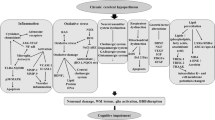Summary.
Increasing life expectancy has raised health problems with respect to ‘normal’ ageing and particularly to age-related disorders. Cerebral oligaemia may become a stress factor during ageing, leading to functional and structural deterioration in the brain. Therefore, the use of adequate reproducible animal models is crucial to study the age-related changes in global cerebral oligaemia as a risk factor for cognitive disturbances. Chronic animal models with 2- or 4-vessel occlusions may have clinical relevance for patients with a high risk of cerebral vessel stenosis or occlusion, e.g. for patients with uni- or bilateral stenosis of the carotid arteries or for patients with dementia. Because cerebral oligaemia may be an additional stress factor during “normal” ageing we conducted studies in young, adult and senescent animals with respect to functional and structural changes in the brain. Using rat models of permanent cerebral vessel occlusions, long-lasting cerebral oligaemia led to: i) disturbed cerebral energy state, ii) discrete changes in neuropathology, iii) moderate cerebral blood flow reduction and iv) marked deterioration in animal behavior. In addition, these findings suggest that many neuronal properties are preserved as compared to acute oligaemia as a result of adaptive mechanisms and that a series of interdependent factors regulate brain ageing.
The challenge to understand the effects of ageing represents a “new frontier” in research, both to prevent degenerative diseases and to reduce their consequences. New aspects of the role of rat models of permanent cerebral oligaemia are considered. These numerous multifactorial approaches are essential to understand the process of ageing and age-related brain disorders. The more we learn about it, the more we realize how to achieve “successful” and “adaptative” ageing. In this contribution we have discussed some of those mechanisms of adaptation and compensation during ageing and subsequent to chronic stress conditions (cerebral oligaemia) related to the vascular system. In the future, these findings could lead to new neuroprotective strategies for counteracting degenerative changes in ageing and in age-associated chronic brain diseases.
Similar content being viewed by others
Author information
Authors and Affiliations
Rights and permissions
About this article
Cite this article
Plaschke, K. Aspects of ageing in chronic cerebral oligaemia. Mechanisms of degeneration and compensation in rat models. J Neural Transm 112, 393–413 (2005). https://doi.org/10.1007/s00702-004-0191-2
Received:
Accepted:
Published:
Issue Date:
DOI: https://doi.org/10.1007/s00702-004-0191-2




